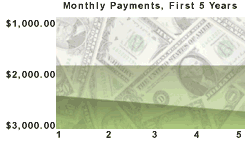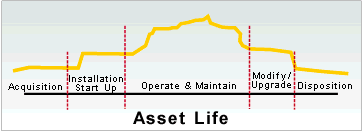Capital Equipment Financing For The Small Shop
A key to the success of any metalworking enterprise is its ability to successfully match an application with a process that can manufacture the part. Likewise, financing new or used capital equipment necessitates partnering with a lender who understands that the business of manufacturing is as much art as science.
Share





Like the incessant calls one receives at home, usually around dinner, to sign up for this or that credit card, many businesses are bombarded with offers for various financing products every day. In reality though, fast growing small and medium manufacturers represent a unique challenge and opportunity for lenders.
Once shop owners drill down to the reality of most financing plans being proffered, they quickly find that creative and truly innovative financing programs are few and far between. This article looks at what traditional capital equipment financing plans offer and then looks at a newly developed approach to the problem.
Nearly all traditional financing programs are pretty much the same loans or leases, five-year terms, two advance payments, some with balloon payments or residual payments. However, for fast-growing young companies and for many small and medium size manufacturers, the lack of cash flow is an all-too-common problem. These shops need distinct programs that are designed to leave them in a better cash flow position with enhanced profitability.
To that end, the production equipment financing program was created by a financial institution that is dedicated to manufacturers. It is a plan that has been designed to address some of the most important issues facing family-owned businesses. These concerns include ways to grow and become more efficient with an eye to preserving working capital, cash flow and equity.
The initiator of this new finance program is First International Bank (Hartford, Connecticut). The production equipment financing program was created with family-owned manufacturing companies in mind. The FDIC member-bank, founded in 1955, specializes in providing innovative credit, trade and financial solutions to small and medium size manufacturing companies both in the United States and in emerging markets internationally.
An example of First International's special capabilities is O-A, Inc., a precision machine shop in Agawam, Massachusetts. This shop produces parts for some of the country's leading jet engine manufacturers. The company had a long-standing relationship with a bank that was purchased by a super-regional bank.
The new people on O-A's account seemed more focused on crunching numbers than learning about its business. First International Bank's understanding of the manufacturing industry and its reputation with other manufacturing businesses moved the O-A principals to change banks.
First International refinanced O-A's debt loan—using a special SBA (Small Business Administration) program targeted specifically for industries that had been affected by defense cuts—and reduced the principal and interest payment by over 30 percent a year. The refinancing gave O-A the cash flow relief to upgrade its heating and air-conditioning systems and insulate the roof of the factory. The company also purchased several new pieces of equipment so it could more efficiently handle the influx of work associated with an industry upswing.
The production equipment financing program was created with the idea of first understanding the unique financial needs of manufacturing and then finding solutions that fit the needs of the business. It's much like finding the right tool, feed and speed to process a given workpiece. But before getting into details about this new financing program, let's get a perspective by looking at the traditional approach to financing.
The Traditional Approach
Loans or leases for machine tools and other capital equipment are typically structured on a term of five years with a maximum term of seven years if the equipment being financed is determined to be of sufficient collateral value. Generally a down payment or advance payments, to be made at closing, are not unusual with a traditional financing arrangement.
In most transactions, each advance payment required on a five-year loan represents a two percent down payment and a higher interest rate. This has immediate impact on working capital and cash flow since often the idea of acquiring capital equipment for a small to medium business is to increase capacity in anticipation of increased demand for production volume.
Traditional financing programs often offer balloon payments. These are sometimes presented as "creative financing." But agreeing to a balloon payment creates a cash flow problem at the end of the term.
The possible need for a refinance at the end of the loan period to meet the balloon payments adds more problems. These include the possibility of higher interest and less flexibility. Usually a three- to four-year term would be available for a refinance of the balloon amount after some level of down payment was made.
Equipment leases have additional aspects, which need to be examined and carefully evaluated. For instance, purchase options can encompass a wide range of possibilities (true fair market value, a $1 purchase option, or a variation of these and other possibilities).
Even firm purchase options (for example, purchase the equipment for $1 at lease expiration) need to be reviewed carefully to ensure that there are not unreasonable requirements for prior written notice from the lessee to trigger the purchase option. Remember that any kind of balloon payment, at lease expiration, is part of the rate/cost formula.
A purchase option, which is based on the fair market value, can be a significant and unanticipated cost! Other aspects of equipment leases that need to be scrutinized include interim rent (this can increase the overall yield for the lessor). One should also look at early termination provisions (these can be a hidden expense), and onerous prepayment penalties (be sure to identify the accounting basis used, for example the Rule of 78's, and the actual prepayment penalty). Caveat Emptor!
Refinancing on existing equipment, if offered, typically is structured on a three-to four-year basis. The maximum term is usually five years. The advance basis for a refinancing will normally be a percentage (70 percent to 80 percent) of orderly liquidation or forced liquidation values according to an independent and, sometimes, expensive equipment appraisal.
A New Solution
The general idea of the new program is to help manufacturers preserve capital and cash flow early in the financing term. Having some cash available helps shops optimize the manufacturing process associated with startup of new equipment. In contract or job shop manufacturing, the early preservation of cash flow gives the shop time to deliver parts and get paid for the job.
First International's program provides equipment loans (with payment terms of up to 15 years) that require a minimal or no down payment. No down payment is required on terms of five to ten years, and only a 5 percent down payment is required on the 15-year loan.
Payments are in arrears. The first payment needs to be made 30 days after closing/funding. This helps enhance working capital when a growing company needs it most.
The extended terms (up to 15 years) are available on a wide range of equipment used in a manufacturer's production process. This can include ancillary equipment (testing, packaging, tooling and so on).
The plan includes fixed and variable rate programs that fit the needs of the manufacturing company. Variable rate programs feature no prepayment penalties. The shop, if it chooses, can double up on payments along the way and effectively shorten the term.
Refinancing And Inflation Hedge
Refinancing of existing equipment on loans with extended terms (up to ten years) and based upon market value of equipment is also part of the new financing package.
A 100 percent advance on market value is offered on a five- to seven-year term with a 95 percent advance on market value on a ten-year term. This maximizes the real value of equipment in terms of working capital especially in comparison to the traditional percentage advance against orderly liquidation values.
Payment structures for the new plan feature declining payments for the life of the loan, which act as a hedge against inflation or deflation, and deliver an immediate boost to profits and cash flow. Initial payments can be 33 percent lower than traditional loans which are a material difference to any business, particularly one that is growing.
Profitability is also enhanced. With these kinds of advantages, manufacturers have the advantage of leveraging this unique financing into an ability to scoop up additional business from their competition.
Growing the Business
The equipment production financing program also mitigates the risk of expanding. U.S. Energy Technologies, Inc., is a Fullerton, California, developer, manufacturer and distributor of consumer plug-in lights, commercial emergency exit-sign lights, and other specialty light products. The company was established in 1992.
After years of steady growth in sales, the company is financing a new $1.1 million production line under a 15-year loan. This maximizes the company's working capital and minimizes cash flow requirements on long term debt at a time when this growing manufacturer needs it most. U.S. Energy has also used First International Bank's "U.S. Import Financing" program, an innovative way to improve cash flow by helping companies arrange considerably longer payment terms—from 90 to 360 days—from their overseas suppliers.
Flexibility
Key to the new financing program is its flexibility to accommodate various needs of manufacturers. Companies can select from numerous options that can tailor the finance plan to a shop's financial strategy.
The new financing program offers fixed and variable rate products with no balloon payments to worry about down the road. Under the popular variable rate program, shops can prepay the entire loan at any time without penalty.
Many customers also like the flexibility of a program that allows them to double up on payments along the way, without penalty. This effectively shortens the term.
Is It For You?
The production equipment financing program offers a new consideration for shops looking to finance production equipment. The program is designed for the business that needs machine tools, fabrication equipment, testing equipment, ancillary equipment or a broad range of other possibilities.
The program loan amount is generally up to $2,000,000 and covers both new and used manufacturing/production equipment. The minimum-time-in-business requirement is three years, and financial statements are required. It's a national program designed to help manufacturers become more productive and profitable.
About the author: Dennis Cesen is vice president of equipment finance at First International Bank (Hartford, Connecticut).
Read Next
Using The Hidden Value In Your Capital Equipment
Metalworking businesses know that if you're not making parts, you're not making money. While that metric is true, your capital equipment may be even more valuable as an asset if managed properly. Here's a look at asset management for metalworking shops.
Read MoreBuilding Out a Foundation for Student Machinists
Autodesk and Haas have teamed up to produce an introductory course for students that covers the basics of CAD, CAM and CNC while providing them with a portfolio part.
Read MoreSetting Up the Building Blocks for a Digital Factory
Woodward Inc. spent over a year developing an API to connect machines to its digital factory. Caron Engineering’s MiConnect has cut most of this process while also granting the shop greater access to machine information.
Read More





























.jpg;maxWidth=300;quality=90)






